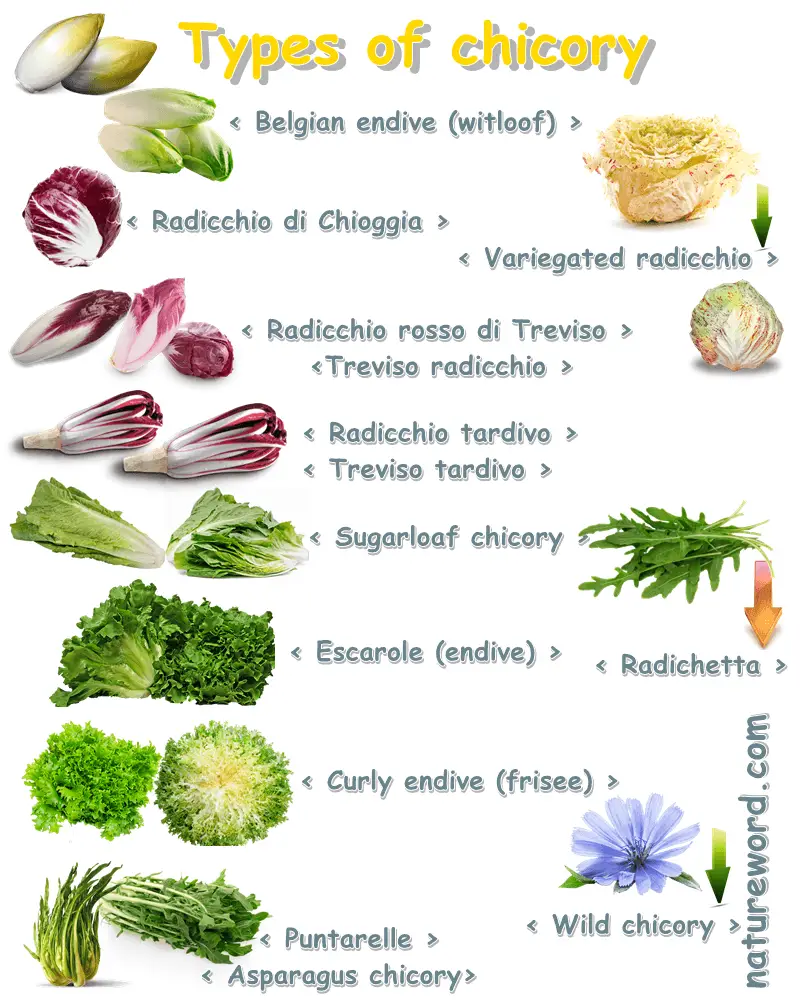What are chicories? What are endives? What is the difference between chicory and endive? What are the different types of chicory and endive? Which types of chicory and endive are used for their leaves and which for their stems or roots? Discover a useful and simple guide to the different types of chicories and endives.
What is chicory?
Chicory is a common name used to denominate all edible salad vegetables in the Cichorium genus. There are two major cultivated species of chicory, and a number of species occurring naturally in the wild, some of which are also edible. One of the two major cultivated species of chicory is known as ‘chicory’, after the genus, while the other species is known as ‘endive’. Chicories include varieties such as radicchio, radichetta, Belgian endives, and root chicory, a subspecies cultivated primarily for its roots, used to make a coffee-like beverage. Endives include leafy green, salad-like varieties that look a lot like lettuce. The names ‘chicory’ and ‘endive’ are often used interchangeably.

What is endive?
Both chicory and endive belong to the chicory genus, hence the reason they are often all called chicories. But chicories and endives are, in fact, two different species of cultivated chicory. More exactly, endives are distinguished as leafy green, salad-like chicories that look a lot like lettuce. Endives are also commonly called ‘true endives’. As a species, the endive is known under the scientific name Cichorium endivia, while actual chicories are known as Cichorium intybus. Wild chicory species are known as Wild chicory Cichorium pumilum.
Types of chicory and endive salads
The different types of chicory and endive include:
- Endive (Cichorium endivia) with two main varieties: broad-leaved endive or escarole (Cichorium endivia latifolia) and curly endive or endive frisée (Cichorium endivia crispum) – both lettuce-like salads
- Common chicory (Cichorium intybus) a weed-like plant with light blue, but also pink and white flowers – produces varieties such as Belgian endives (also called French endives), radicchio, witloof or witlof, puntarelle (also called asparagus endive, Catalonian chicory or Italian dandelion endive), sugarloaf chicory and radichetta (a variety of Catalonian chicory).
- Root chicory (Cichorium intybus sativum), a variety of common chicory whose roots are dried, roasted and finely ground for use as a coffee substitute.
- Wild chicory (Cichorium pumilum), a weed-like herb with blue-violet flowers.

What is root chicory?
Root chicory is a variety of common chicory, more exactly, a subspecies of one of the two main cultivated species of common chicory (scientific name: Cichorium intybus sativum). As its name suggests, root chicory is cultivated for its roots which are used to make a coffee substitute. Root chicory coffee is naturally caffeine-free which makes it a good option for people with arrhythmia, palpitations or extrasystoles, and high blood pressure for whom caffeine is contraindicated.
The roots are high in inulin which probiotic effects, and contribute to good gut bacteria populations and the health of the gut medium. Root chicory coffee is pleasantly bitter, with earthy flavor notes.
What is salad chicory?
Salad chicory refers to all varieties of chicory, both chicories and endives, that can be used for salad. This includes lettuce-like endives such as broad-leaved endive (or escarole) and curly endive (or endive frisee), and chicories like Belgian endive, radicchio, puntarelle (Catalonia chicory or Italian dandelion chicory), and leafy sugarloaf chicory and radichetta. Typically, chicories, endives included, have a bitter taste of varying intensity.
What are chicory greens?
Chicory greens typically refer to varieties of chicory and endives with leafy green leaves. This includes:
- lettuce-like endives such as broad-leaved endive (or escarole) and curly endive (or endive frisee)
- common chicories such as sugarloaf chicory, puntarelle or Catalonia chicory and radichetta
- wild chicory leaves
What are endives?
In colloquial language, the term ‘endive’ may be used interchangeably to denominate both true endives and chicories.
- Endive can mean true endives: lettuce-like escarole (broad-leaved endive) and endive frisee (curly endive).
- Endive can mean chicories with crisp, tightly-wrapped, dense leaf heads – that look like loaves (e.g. Belgian endives) or cabbages (e.g. radicchio).
- Or it can mean both, depending on regional and personal uses of the term ‘endive’.
- The term ‘endive’ can also be used to refer exclusively to Belgian endives.
What are Belgian endives?
Belgian endive is actually not a true endive, but a type of common chicory (scientific name: Cichorium intybus). The Belgian endive is a type of blanched chicory shaped like a loaf of bread, with tightly packed crisp, almost cabbage-like leaves. Depending on how it’s grown, Belgian endive can be almost completely white, with just a bit of pale green or yellow-green at the top, or about halfway colored. Color develops on the parts exposed to sunlight and the leaves can be pleasantly bitter to very bitter.
What is witloof or witlof chicory?
Witloof chicory, also spelled witlof, is actually Belgian endive. The names ‘witloof’ and ‘witlof’ are Dutch, but also used in the US. An important thing to note: witloof chicory is an actual chicory.
What is French endive?
French endive is another name for Belgian endive, and it’s a type of chicory. In some parts of the English speaking world, the same foods are called differently.
What is asparagus chicory?
Asparagus chicory (‘cicoria asparago’ in Italian) is a variety of common chicory (scientific name: Cichorium intybus foliosum). It’s also called:
- Catalonian chicory after the region in Italy where it’s grown (in Italian, ‘cicoria di Catalogna’).
- Italian dandelion chicory, to mark the fact that it’s related to dandelions, and its leaves are serrated and resemble those of dandelions.
- Puntarelle, a name borrowed directly from Italian.
In some parts of the world, the name ‘puntarelle’ is used to refer not to the whole vegetable, but only to the younger central stalks.
Like other chicories, asparagus chicory has a mild to pregnant bitter taste. You can eat both the leaves and crisp stems, raw and cooked. Find out more about asparagus chicory – what it looks like, what to do with it and what are the benefits and side effects.
What is puntarelle?
Puntarelle is an alternative name for asparagus chicory, a variety of common chicory (scientific name: Cichorium intybus foliosum). It goes by other names as well: Catalonian chicory, Italian dandelion chicory, or puntarelle greens which only refers to the leaves.
What is radicchio?
Radicchio is a popular Italian vegetable, a variety of common chicory. It’s also commonly called ‘radicchio rosso’ to mark its particular color palette: deep purple-red or magenta leaves with snow-white veins and base. It’s also sometimes called red endive or red chicory.
- The variety called ‘radicchio di Chioggia’ looks like a smaller red-purple cabbage, with dense and crisp, tightly packed magenta leaves with white veins.
- The variety ‘radicchio rosso di Treviso’ looks a lot like a Belgian endive, shaped like a loaf, but with deep red to purple-red leaves with white veins and base.
- The variety called ‘radicchio tardivo’ or ‘radicchio tardivo Treviso’ is shaped somewhat like a lightbulb, with tightly packed, crisp white and magenta, stem-like leaves that curl at the top.
- The variety called ‘radicchio di Castelfranco’, also known as variegated radicchio, is actually a lettuce-like type of radicchio with light green to yellow-green or cream leaves, speckled to various degrees with red-purple. This particular type is not a true radicchio, but a cross between red radicchio and broad-leaved endive (escarole). Compared to radicchio which can have a moderate to intense bitter taste, variegated radicchio has pleasant bitter and sweet flavor notes.
What is radichetta?
Radichetta is a variety of common chicory called Catalonian chicory or Catalonian lettuce, scientific name Chicorium intybus foliosum. It’s essentially a leafy green salad with a more pleasant bitter taste.
Radichetta has long, somewhat thinner or narrower leaves compared to broader lettuce salads, and ranges in color from light green to dark green.
The leaves are ragged and resemble dandelion leaves. Young radichetta salad is mildly bitter, with fresh green flavor notes and soft, tender leaves, while older radichetta tastes quite bitter, with chewier leaves.
What is sugarloaf (chicory)?
Sugarloaf, also called sugarloaf chicory or sugarloaf endive, is a variety of cultivated leaf chicory meant for use as salad. Sugarloaf is quite similar in taste and appearance to Romaine lettuce. As its name suggests, sugarloaf grows into a loaf-like shape, but with leafier greens – it looks like a leafy, green Belgian endive. But if left to mature enough, the leaves spread and the sugarloaf starts looking more like a lettuce salad.
